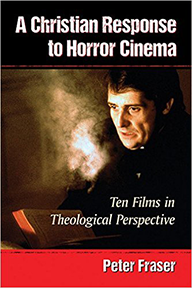Call Me Legion: Excerpt from Peter Fraser’s Analysis of Horror Cinema
It would be conventional to say that some of us are simply more impressionable. And while that is certainly true, horror film surmises that the easiest victims of the diabolic are those who have no healthy fear and respect for the subject. The Church has taught for centuries that the Devil and demons prey on the foolish, and a prevalent motif in horror film reminds us that the goal of Evil with the capital letter is to incarnate itself within the foolish.

Each reader can decide how to measure these metaphysics. The intention is to open or reopen a serious conversation about the what and the why of horror and how sensible people, and especially sensible people who believe in things that go bump in the night, might respond. I want to explain where the horror genre came from, how it works, and what it suggests about the trajectory of the culture through the twentieth century. This book in no way attempts to validate the genre; the market has already done that. Horror films grossed nearly a half billion dollars in the United States just last year.
Contrary as it may seem to argue in an “enlightened” world built upon the collective denial of the possibility of not only a personal God, but a personal devil, the genre of horror insists that what lies beneath our dread of the mysterious and dangerous unknown that horror explores is a grisly un-reality that if seen without the ghostly veils would make Milton’s Pandemonium seem a rather familiar place. Beware simple explanations. We might think we understand what we see and hear in the story, just as we may think we can wake from the darkness of the screening room to the cool and refreshing outdoor air, but to think such thoughts is to dismiss the obvious implications of what has drawn us and what w e have seen in the darkness, not to mention the cold finger just touching our spine. The camera journey of horror film makes plain that something is indeed down there waiting to come up and out, and that our curious and foolish assent to see it has awakened the attention and pleasure of this Beast who loves the curious fool most of all.
The most effective horror films command the viewer’s attention like no other film art. They scratch at a fundamental metaphysic of a damaged universe where misguided creatures make catastrophic choices. That is to say, the fallen deny their desire to rebel against the world’s natural balances, and so hide a secret longing to see and experience, if only momentarily, the anarchy behind the wall hiding the domain of the devil. In the horror genre, victim and viewer are compelled to admit these dark desires, and spiritual and moral denials. Once the toll is paid to enter the theater, access is granted to brief glimpses of an unchecked will to evil; and thus, the victim-viewer is compelled to acknowledge evil’s personal existence, as well as a self-deluded, secret love of its ways. No, it is not only a movie, as one tag-line suggested. If it were, if horror were only a seek-and-reveal genre game, the genre should have lost some measure of its popular power after nearly a century, and viewers wouldn’t be found so often trembling in the corner of the wrong tent. The truly dreadful horror films compel the visitor to check all sophistries and denials, while at the same time offering a false promise that this innocent gesture of paying for a ticket to a teasing journey into the underworld will have no significant bearing on the naïve pilgrim.
What I hope comes across as unique in this book is the blending of two seemingly disparate approaches. One analyzes the remarkable achievements of several major artists working in this very dark genre, and does so in a sophisticated way. The other acknowledges the source of horror from the position of historical theology; that is, as the old faith assumed very specific things about the inner workings of this world and the unseen world that circles around it, so this book begins with the older assumption that the human race was lost by a choice which followed a temptation, and that behind the temptation was a spiritual presence. The tension between those two approaches might be best resolved in a truism that both saints and artists have embraced through all the centuries, that in the workings of our mysterious creation there remains something fundamentally inexplicable about human experience, alternately joyful and terrifying, something that makes obedience along the way both a cause for wonder and a necessity for survival and salvation.
